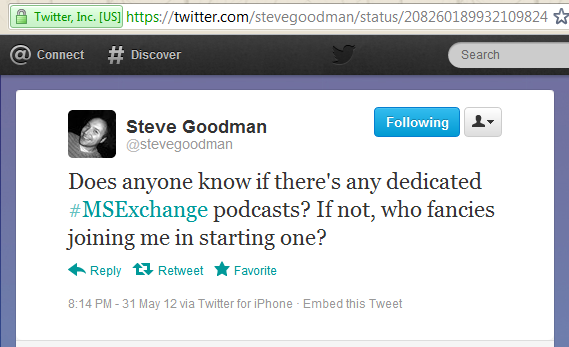The UC Architects Podcast – Oh My God, They Let Me Host!
4 or 5 weeks ago, fellow MVP Steve Goodman sent out a tweet about possibly starting a podcast, and asking if anyone was interested in participating.
There was quite a response, and 13 people in total started “The UC Architects Podcast” project. Within about 2 weeks, a website was born, Twitter, Facebook, and LinkedIn accounts were up and running, and the first episode was recorded. Steve hosted that episode, and four of the group were co-hosts. Post production editing was performed, and the episode was launched via web, iTunes, Zune, and RSS. What an accomplishment!
That first episode was quite a learning experience for all involved. Not only did topics need to be chosen and discussed, but the technical details of producing a podcast had to be researched. That first episode was recorded as a Lync conference, and the resulting audio pointed to possible improvements in recording hardware, techniques, etc. Every step of the way was based on group decisions and suggestions. When it came time to start discussing episode two, I was honored to be chosen as the host. Steve set a high bar with the first episode, and I was excited yet nervous at the opportunity.
I created a simple text file that was essentially a brain dump of ideas I had about what to discuss from a technical perspective about Lync and Exchange, as well as including some things we missed in episode 1, like mentioning our website, Facebook page, and other details. Topics are chosen by consensus of the group, but I had some ideas for “mini feature”. I listened to episode 1 several times, as well as my normal podcast subscriptions like TWiT, The Tech Guy, and others. Once I had a long list, I organized it into a flow of the complete episode. My plan was to work from the top down. This would help me stay focused, as well as making sure I didn’t forget something.
Scheduling a conference call involving a half dozen people scattered around the world was probably the most challenging issue. We used http://www.doodle.com to figure out the best schedule for everyone. Unfortunately, this resulted in a couple of the originally scheduled architects to not be available, so a couple of others stepped in. This also caused a couple of changes to the proposed topics as well.
When the time came to hold the Lync conference call, we had a brief meeting before starting the episode, and I shared out the notes in Lync so that everyone could see them. This turned out to be quite beneficial, as the co-hosts could see what was coming up. An occasional IM by the others, including the episode’s producer Dave Stork, really helped the show flow. I could, however, tell that my normal public speaking issue was coming into play – I was rushing things.
I managed to step back a little and let the co-hosts run with some topics and stretch things out a little. This really helped me relax a little, and ensure I wasn’t dominating the conversation as much.
We wrapped up all of the items on the list, and I closed the episode. Once that was done, we had a quick discussion on something that we missed, so we just picked it back up, discussed the topic, and it was later edited into the right place of the recording.
A post-recording briefing was beneficial for discussing the episode, and then the recording was off to the editor, Michael van Horenbeeck. An episode specific graphic was created, the episode’s summary page was created, the files were updated, and lastly, the podcast XML file was updated. At that point, the episode was live, and available online. Well, after I fixed a typo in the XML file. Whoops. At that point, many of the guys in the group begin socialized the episode via blog posts, Twitter, and Facebook.
What an experience! As much as I, like many people, don’t like to hear the sound of their own voice, I listened to the final edit and made notes on a couple of areas, including meeting flow, speaking styles, and audio quality. The audio quality is somewhat limited mainly due to Lync’s recording mechanism and embedded codecs, however we continue to tweak. Little quirks like the background sound of people playing with their mic, typing on their keyboard, or Windows sounds like Lync IM notifications were noted as areas for improvement. And my own speaking style didn’t escape my critique. Lots of “um” and “ah” type comments were fortunately edited out, but a few still remained. And I think I sounded a little stiff. But I managed to survive and had a ton of fun.
Steve is returning as host for episode 3, with me likely returning for episode 4. Even as episode 2 was being posted, I realized there has been ~700 emails between the group! Plus IMs, Lync calls, etc. Planning is well underway for episodes 3 and 4, and I’m excited to see what’s next. We’re planning on having people from the Lync and Exchange product groups, as well as vendors and other UC architects as guests in upcoming episodes.
Be sure to check out the podcast and let me know your thoughts, suggestions, and critiques.






Follow Me